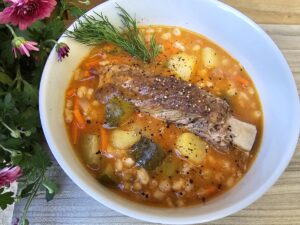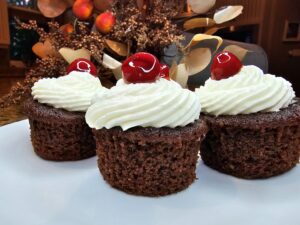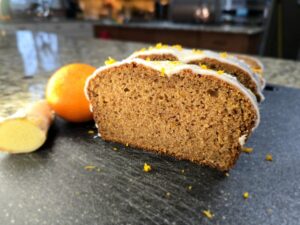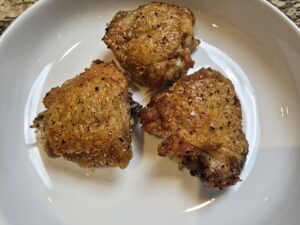A Perfectly Balanced, Bakery-Level Dessert for the Home Kitchen
This is Not an Easy Recipe.
I want to start with that upfront because Bienenstich (Bee Sting Cake) is not a beginner-friendly bake. This is an intermediate to expert-level recipe, and if you’re new to yeast doughs, custards, or laminated-style breads, you will struggle.
But here’s the good news:
I’ve structured this recipe across two days to make it as streamlined and foolproof as possible. If you follow my exact steps without shortcuts, you will create a stunning, bakery-quality Bee Sting Cake.
But if you rush, skip a proofing step, or don’t take precision seriously—well, I’ll say it bluntly: your cake will suffer for it.
Why Many Bee Sting Cake Recipes Fail
There are a lot of bad Bienenstich recipes online. But if you look at the instructions, or even pictures – you can detect that many lack that perfect softness that brioche demands.
Why This Is the Best Bee Sting Cake Recipe
This recipe is engineered for perfection while still being achievable in a home kitchen.
Key Strengths:
✔ We merge elite bakery techniques (cold proofing, precise yeast use, controlled caramelization).
✔ We use strategic flour adjustments (a 50/50 bread flour & all-purpose blend) to balance structure and softness.
✔ Our pastry cream is stabilized with gelatin for a light-as-air, custard-like mousse that holds its shape.
✔ Every step is designed with precision, eliminating common mistakes that ruin lesser recipes.
This is not just my #1 favorite everyday cake—this is our family’s favorite dessert of all time.
Yes, we have special treats for the holidays, but when a craving for something sweet hits? This is what we make.
It’s not just a cake. It’s a pastry, a bread, and a dessert all in one.
Almost like a cream-filled, light-as-air donut, but with the depth of brioche.
What is Bee Sting Cake?
Bienenstich is a classic German cake consisting of:
✔ A soft, airy brioche base – Slightly chewy yet feathery, rich yet light.
✔ A caramelized honey-almond topping – Crisp and golden, with the perfect balance of crunch and chew.
✔ A dreamy pastry cream filling – Stabilized with whipped cream for a silky, mousse-like texture that melts in your mouth.
It’s a perfect cross between pastry and cake.
Brioche alone is a masterpiece, but when layered with toasted honey almonds and delicate vanilla custard, it becomes something truly extraordinary.
How We Make It Perfect (A 2-Day Process)
This is a precision-based bake, but by breaking it into two days, we make it achievable and straightforward.
Day 1: We make the brioche dough and let it cold ferment overnight for depth of flavor and easy handling.
Day 2: We shape, proof, bake, and layer the cake with custard and caramelized almonds.
Every component is carefully constructed for optimal texture and stability.
Final Thoughts: This is THE Bee Sting Cake to Make
If you’ve ever had a disappointing Bee Sting Cake, I promise—this recipe fixes all of it.
Perfect brioche structure
Silky, stabilized pastry cream
Caramelized almond topping done right
If you follow the process precisely, you’ll create the most heavenly Bienenstich you’ve ever tasted.
Trust the method. Trust the science. Then take that first bite—and fall in love.
A Brief History of Bee Sting Cake (Bienenstich)
Bee Sting Cake, or Bienenstich, is a traditional German dessert with a fascinating origin story. Though the exact details are debated, legend has it that the cake dates back to the 15th century when German bakers successfully defended their village from an attack by throwing beehives at invaders. To celebrate their victory, they created a new dessert—one with a sweet, honey-infused almond topping that resembles the golden hues of a beehive.
Historically, Bienenstich has been a staple in German bakeries, often enjoyed as an afternoon treat alongside coffee. Unlike typical cakes, it leans more towards a pastry-like brioche base, setting it apart from other cream-filled desserts. The combination of light, airy bread, caramelized almonds, and rich custard makes it a unique cross between a cake, a cream-filled donut, and a pastry, making it as special today as it was centuries ago.
Bee Sting Cake (Bienenstich) is Bavarian in origin, specifically from southern Germany. While the broader legend of the cake dates back to the 15th century, its true roots are in Bavarian baking traditions, where it became a staple in German konditoreien (pastry shops).
Bavaria, known for its rich baking heritage, is home to some of the most famous German desserts, including Schwarzwälder Kirschtorte (Black Forest Cake) and Dampfnudeln (sweet steamed dumplings). Bienenstich fits perfectly within this tradition—a yeasted, brioche-like base instead of a sponge cake, a caramelized honey-almond topping, and a luscious cream filling.
Originally, the cake was often served as a festive dessert or celebratory treat, and it remains a beloved classic in both Germany and Austria. Today, variations exist, with some regions using buttercream instead of pastry cream, but the core elements—a light, golden brioche, a crunchy almond crust, and a creamy filling—remain unchanged.
Bee Sting Cake
Ingredients
For the Dough:
1 recipe The Best Brioche
*Please note, I suggest replacing half the flour with regular all purpose flour.
Bread flour alone can make the crumb a bit too chewy, while all-purpose flour alone may reduce structure.
Fix:
A 50% Bread Flour + 50% All-Purpose Flour mix would soften the crumb while maintaining structure.For the Pastry Cream Filling:
1 cup whole milk, divided
4 tablespoons granulated sugar, divided
3/4 of vanilla bean, seed scraped, optional
1 pinch kosher salt
2 tablespoons cornstarch
2 large egg yolks
1 tablespoon unsalted butter
2 tsp vanilla extract
4 teaspoons water
3/4 teaspoon powdered unflavored gelatin
3/4 cup cold heavy cream
3 tablespoons powdered sugarFor the Topping:
4 tablespoons (1/2 stick) unsalted butter
3 tablespoons honey
3 tablespoons granulated sugar
1/4 of vanilla bean, seed scraped, optional
1 pinch kosher salt
1 cup sliced almonds
1/4 tsp almond extract
1/2 tsp vanilla extract
Directions
- Day 1: Make the Dough
Steps 1 through 4 of my Brioche recipe. But instead of refrigerating for the minimum 2 hours, let's refrigerate it overnight. - Day 2: Shaping
Remove the dough from the refrigerator and lightly punch it down. Press the cold dough into a greased 8- or 9-inch springform pan, smoothing it out evenly.
Cover the pan with a damp towel and plastic wrap. Let rise in a warm place until puffed, about 1 - 1 1/2 hours.
Preheat the oven to 356°F. Place a parchment-lined baking tray under the pan to catch drippings. - Day 2: Make the Topping and Bake:
In a small saucepan, melt the butter over medium heat. Stir in honey, sugar, vanilla paste, and salt. Simmer briefly.
Stir in the sliced almonds. Remove form heat, stir in the vanilla and almond extracts, then set aside until ready to spread on the dough. Let the topping cool slightly (~5 minutes) before spreading—this ensures it spreads evenly without sinking into the dough.
Once the dough is done rising, spread the prepared topping over the dough. Bake for 21–25 minutes, until the internal temperature reaches 188-190°F and the top is golden brown. Run a knife around the edges immediately after baking to prevent sticking. Let cool for 20 minutes in the pan, then carefully remove and cool completely on a wire rack. This will take at least 1 1/2 hours. - Make the Pastry Cream Filling:
In a medium saucepan, heat 3/4 cup milk, 2 tablespoons sugar, vanilla paste, and salt until just simmering.
In a bowl, whisk the remaining 1/4 cup milk with cornstarch, the remaining sugar, and egg yolks until smooth and lightened. Slowly whisk half of the hot milk into the yolk mixture, then return to the saucepan. Cook, whisking constantly, until thickened.
Remove from heat, add butter and vanilla extract, and strain through a fine-mesh sieve. Cover with plastic wrap directly on the surface and refrigerate until cool.
Bloom gelatin in water, then melt in the microwave. Whip the heavy cream and powdered sugar in a stand mixer, gradually incorporating the melted gelatin, until stiff peaks form.
Beat the chilled pastry cream until smooth, then fold in 1/3 of the whipped cream to lighten in. Then gently fold in the rest of the whipped cream, folding very gently until incorporated. - Assembly:
Slice the cake horizontally. Spread the filling onto the bottom layer, then place the top layer over it.
Chill the assembled cake in the refrigerator for at least 1 hour before serving.
Enjoy your beautifully layered bee sting cake!
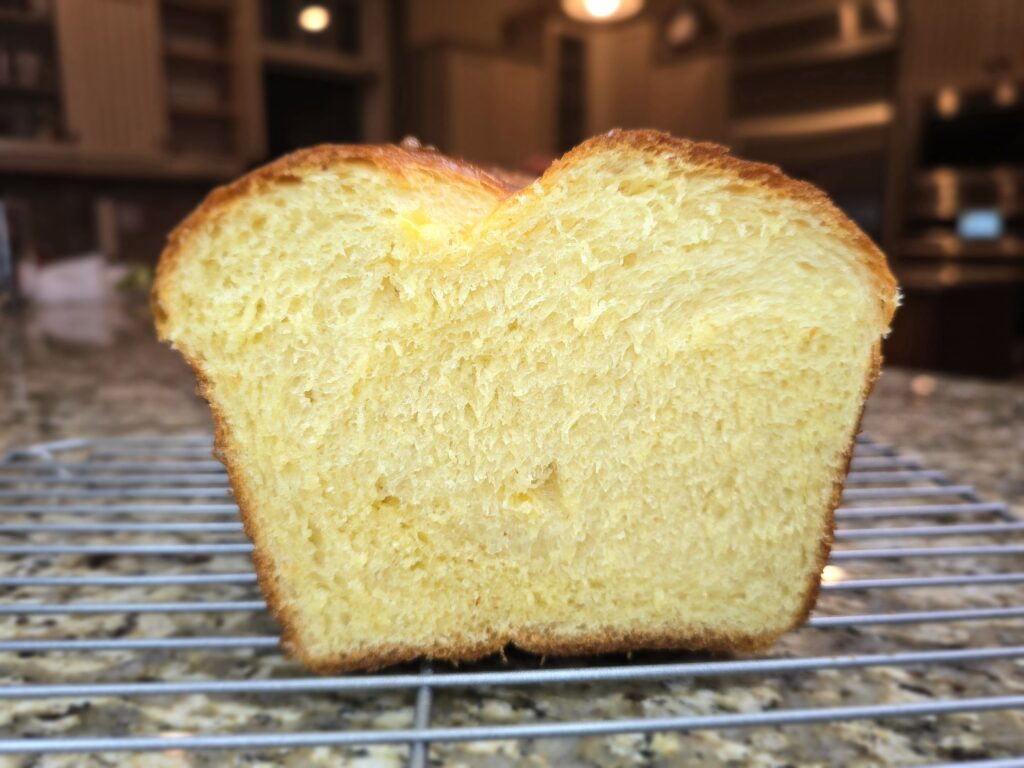
This is a picture of my brioche recipe so you can see just how tender it is!! I must admit, I didn’t take a picture of a slice of my Bee Sting Cake. Next time I make it – I’ll correct the issue!







